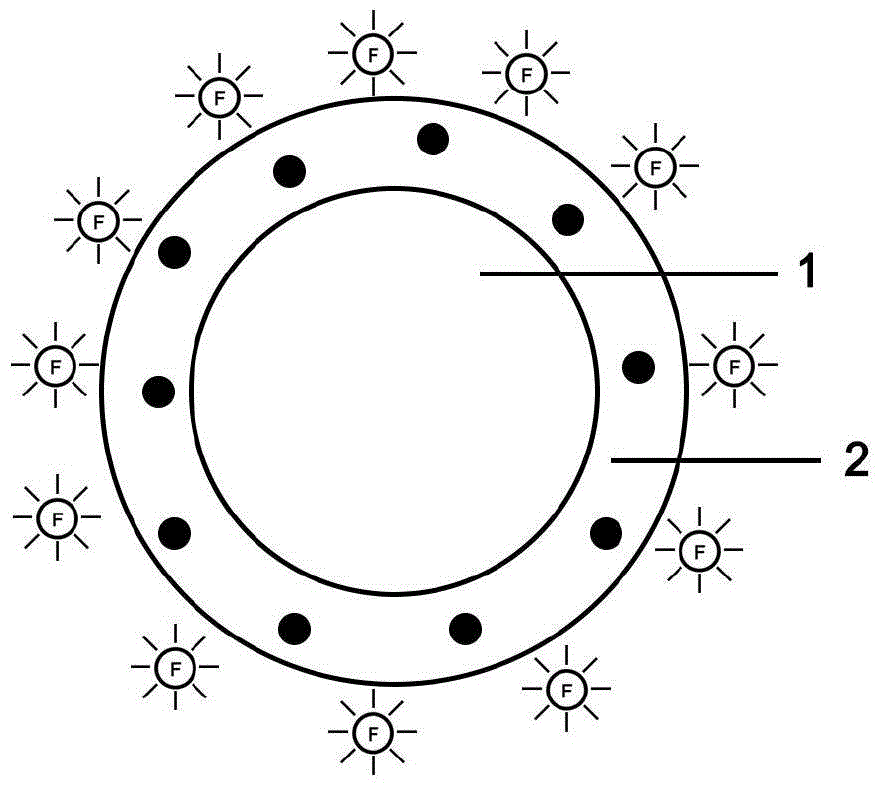A preparation method of fluorescent nanocomposite with drug release function
A technology of fluorescent nano-composites, applied in the field of preparation of fluorescent nano-composites, can solve the problems of cumbersome monitoring methods and low sensitivity, and achieve the effect of expanding practicability
- Summary
- Abstract
- Description
- Claims
- Application Information
AI Technical Summary
Problems solved by technology
Method used
Image
Examples
Embodiment 1
[0022] (1) The silver ammonia solution that the silver ion concentration is the fresh configuration of 1 millimole per liter is quickly added in the tannic acid solution that the concentration of equal volume is 0.1 millimole per liter, stirs rapidly at room temperature for half an hour to one hour, prepares Spherical silver nanoparticles with an average diameter of 25 nm. After the reaction is completed, the silver nanoparticles are centrifugally washed and dispersed in deionized water of equal volume for use;
[0023] (2) With a volume ratio of 1:5, add a freshly configured cystine solution with a concentration of 1 mmol per liter to a silver nanoparticle solution with a concentration of 10 nanomol per liter, stir at room temperature for 5 hours, and then centrifuge and wash Silver nanoparticles, the solution volume is concentrated 5 times;
[0024] (3) With a volume ratio of 250:1, in a concentration of 0.5 mg per milliliter of polylysine solution, a concentration of 5 mmo...
Embodiment 2
[0028] (1) Get the chloroauric acid solution that the mass fraction is 0.01%, boil, with the volume ratio 133:1, add the sodium citrate solution that mass fraction is 1% wherein, keep boiling for 30 minutes, the obtained average diameter is 25 nanometers of gold nanoparticles;
[0029] (2) Adjust the pH value of the solution to pH=8, and add a freshly configured cysteine solution with a concentration of 1 mmol per liter to the gold nanoparticle solution prepared in step (1) at a volume ratio of 1:20 , stirring at room temperature for 5 hours, then centrifuging and washing the gold nanoparticles to remove unreacted cysteine, collecting the centrifuged gold nanoparticles and concentrating them by 5 times in volume;
[0030] (3) With a volume ratio of 250:1, a concentration of 1 mg per milliliter of polylysine solution was added to a concentration of adriamycin solution of 5 mmol per liter, and after stirring evenly, the pH value of the solution was adjusted to pH = 10, and th...
Embodiment 3
[0034] (1) Get the chloroauric acid solution that the mass fraction is 0.01%, boil, with the volume ratio 133:1, add the sodium citrate solution that mass fraction is 1% wherein, keep boiling for 30 minutes, the obtained average diameter is 25 nanometers of gold nanoparticles;
[0035] (2) Adjust the pH value of the solution to pH=8, and add the freshly configured 2-mercaptoethylamine solution with a concentration of 1 mmol per liter to the gold nanoparticle solution prepared in step (1) at a volume ratio of 1:20 , stirring at room temperature for 5 hours, then centrifuging and washing the gold nanoparticles to remove unreacted cysteine, collecting the centrifuged gold nanoparticles and concentrating them by 5 times in volume;
[0036] (3) With a volume ratio of 250:1, add a doxorubicin solution with a concentration of 5 mmol per liter to a polylysine solution with a concentration of 2 mg per milliliter, stir evenly, and adjust the pH value of the solution to pH =10, then add...
PUM
| Property | Measurement | Unit |
|---|---|---|
| diameter | aaaaa | aaaaa |
Abstract
Description
Claims
Application Information
 Login to View More
Login to View More - R&D
- Intellectual Property
- Life Sciences
- Materials
- Tech Scout
- Unparalleled Data Quality
- Higher Quality Content
- 60% Fewer Hallucinations
Browse by: Latest US Patents, China's latest patents, Technical Efficacy Thesaurus, Application Domain, Technology Topic, Popular Technical Reports.
© 2025 PatSnap. All rights reserved.Legal|Privacy policy|Modern Slavery Act Transparency Statement|Sitemap|About US| Contact US: help@patsnap.com

